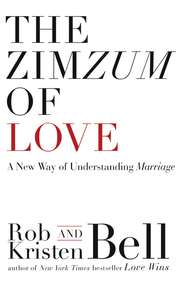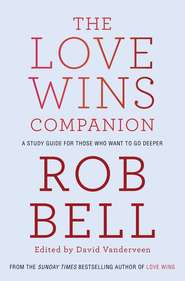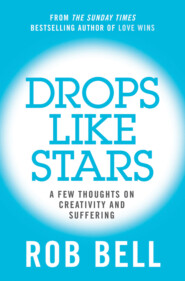По всем вопросам обращайтесь на: info@litportal.ru
(©) 2003-2024.
✖
The Complete Rob Bell: His Seven Bestselling Books, All in One Place
Автор
Год написания книги
2018
Настройки чтения
Размер шрифта
Высота строк
Поля
Jesus is more compelling than ever. More inviting, more true, more mysterious than ever. The problem isn’t Jesus; the problem is what comes with Jesus.
For many people the word Christian conjures up all sorts of images that have nothing to do with who Jesus is and how he taught us to live. This must change.
For others, the painting works for their parents, or it provided meaning when they were growing up, but it is no longer relevant. It doesn’t fit. It’s outdated. It doesn’t have anything to say to the world they live in every day. It’s not that there isn’t any truth in it or that all the people before them were misguided or missed the point. It’s just that every generation has to ask the difficult questions of what it means to be a Christian here and now, in this place, at this time.
And if this difficult work isn’t done, where does the painting end up?
In the basement.
Here’s what often happens: Somebody comes along who has a fresh perspective on the Christian faith. People are inspired. A movement starts. Faith that was stale and dying is now alive. But then the pioneer of the movement—the painter—dies and the followers stop exploring. They mistakenly assume that their leader’s words were the last ones on the subject, and they freeze their leader’s words. They forget that as that innovator was doing his or her part to move things along, that person was merely taking part in the discussion that will go on forever. And so in their commitment to what so-and-so said and did, they end up freezing the faith.
What gets lost is the truth that whoever painted that version was just like us, searching for God and experiencing God and trying to get a handle on what the Christian faith looks like. And then a new generation comes along living in a new day and a new world, and they have to keep the tradition going or the previous paintings are going to end up in the basement.
The tradition then is painting, not making copies of the same painting over and over. The challenge of the art is to take what was great about the previous paintings and incorporate that into new paintings.
And in the process, make something beautiful—for today.
For many Christians, the current paintings are enough. The churches, the books, the language, the methods, the beliefs—there is nothing wrong with it. It works for them and meets their needs, and they gladly invite others to join them in it. I thank God for that. I celebrate those who have had their lives transformed in these settings.
But this book is for those who need a fresh take on Jesus and what it means to live the kind of life he teaches us to live. I’m part of a community, a movement of people who have been living, exploring, discussing, sharing, and experiencing new understandings of Christian faith.
And we love it. We are alive in ways we never thought possible. We are caught up in something we gladly give our lives to. This is the place that I write from: a place of joy and freedom, as a member of a community wanting to invite others to come along on the journey. We are just getting started. I have as many questions as answers, and I’m convinced that we’re only scratching the surface. What I do know is that this pursuit of Jesus is leading us backward as much as forward.
If it is true, then it isn’t new.
I am learning that what seems brand new is often the discovery of something that’s been there all along—it just got lost somewhere and it needs to be picked up, dusted off, and reclaimed. I am learning that I come from a tradition that has wrestled with the deepest questions of human existence for thousands of years. I am learning that my tradition includes the rabbis and reformers and revolutionaries and monks and nuns and pastors and writers and philosophers and artists and every person everywhere who has asked big questions of a big God.
Welcome to my Velvet Elvis.
MOVEMENT ONE Jump (#ulink_90b93fdb-fa0c-5106-b8f3-4bb03a1d37fb)
Several years ago my parents and in-laws gave our boys a trampoline. A fifteen-footer with netting around the outside so kids don’t end up headfirst in the flowers. Since then my boys and I have logged more hours on that trampoline than I could begin to count. When we first got it, my older son, who was five at the time, discovered that if he timed his bounce with mine, he could launch higher than if he was jumping on his own.
I remember the first time he called my wife, Kristen, out into the backyard to watch him jump off of my bounce. Now mind you, up until this point he was maybe getting a foot higher because of his new technique. But this one particular time, when my wife was watching for the first time, something freakish happened in the space-time continuum. When he jumped, there was this perfect convergence of his weight and my weight and his jump and my jump, and I’m sure barometric pressure and air temperature had something to do with it too, because he went really high.
I don’t mean a few feet off the mat. I mean he went over my head. Forty pounds of boy, clawing the air like a cat thrown from a second-story window, and a man making eye contact with his wife and thinking, This is not good.
She told us she didn’t think our new trick was very safe and we should be careful. Which we were.
Until she went inside the house.
It is on this trampoline that God has started to make more sense to me. Because when it comes to faith, everybody has it. People often tell me they could never have faith, that it is just too hard. The idea that some people have faith and others don’t is a popular one. But it is not a true one. Everybody has faith. Everybody is following somebody. What often happens is that people with specific beliefs about God end up backed into a corner, defending their faith against the calm, cool rationality of others. As if they have faith and beliefs and others don’t.
But that is not true. Let’s take an example: Some people believe we were made by a creator who has plans and purposes for his creation, while others believe there is no greater meaning to life, no grand design, and we exist not because of some divine intention but because of random chance. This is not a discussion between people of faith and people who don’t have faith. Both perspectives are faith perspectives, built on systems of belief. The person who says we are here by chance and there is no greater meaning has just as many beliefs as the person who says there’s a creator. Maybe even more.
Think about some of the words that are used in these kinds of discussions, one of the most common being the phrase “open-minded.” Often the person with spiritual convictions is seen as close-minded and others are seen as open-minded. What is fascinating to me is that at the center of the Christian faith is the assumption that this life isn’t all there is. That there is more to life than the material. That existence is not limited to what we can see, touch, measure, taste, hear, and observe. One of the central assertions of the Christian worldview is that there is “more.”1 (#ulink_89cf3938-0638-5856-99d0-63ef896c083a) Those who oppose this insist that this is all there is, that only what we can measure and observe and see with our eyes is real. There is nothing else. Which perspective is more “closed-minded”? Which perspective is more “open”?
An atheist is a person of tremendous faith. In our discussions about the things that matter most then, we aren’t talking about faith or no faith. Belief or no belief. We are talking about faith in what? Belief in what? The real question isn’t whether we have it or not, but what we have put it in.
Everybody follows somebody. All of us make decisions every day about what is important, how to treat people, and what to do with our lives. These decisions come from what we believe about every aspect of our existence. And we got our beliefs from somewhere. We have been formed, every one of us, by this complicated mix of people and places and things. Parents and teachers and artists and scientists and mentors—we are each taking all of these influences and living our lives according to which teachings we have made our own. Some insist that they aren’t influenced by any person or any religion, that they think for themselves. And that’s an honorable perspective. The problem is they got that perspective from . . . somebody. They’re following somebody even if they insist it is themselves they are following.
Everybody is following somebody. Everybody has faith in something and somebody.
We are all believers.
Way
As a Christian, I am simply trying to orient myself around living a particular kind of way, the kind of way that Jesus taught is possible. And I think that the way of Jesus is the best possible way to live.
This isn’t irrational or primitive or blind faith. It is merely being honest that we all are living a “way.”
I’m convinced being generous is a better way to live.
I’m convinced forgiving people and not carrying around bitterness is a better way to live.
I’m convinced having compassion is a better way to live.
I’m convinced pursuing peace in every situation is a better way to live.
I’m convinced listening to the wisdom of others is a better way to live.
I’m convinced being honest with people is a better way to live.
This way of thinking isn’t weird or strange; it is simply acknowledging that everybody follows somebody, and I’m trying to follow Jesus.
Over time when you purposefully try to live the way of Jesus, you start noticing something deeper going on. You begin realizing the reason this is the best way to live is that it is rooted in profound truths about how the world is. You find yourself living more and more in tune with ultimate reality. You are more and more in sync with how the universe is at its deepest levels.
Jesus’s intention was, and is, to call people to live in tune with reality. He said at one point that if you had seen him, you had “seen the Father.”2 (#ulink_3d5ac8a1-67b7-5aa6-9eff-520d78524c7a) He claimed to be showing us what God is like. In his compassion, peace, truth telling, and generosity, he was showing us God.
And God is the ultimate reality. There is nothing more beyond God.
Jesus at one point claimed to be “the way, the truth, and the life.” Jesus was not making claims about one religion being better than all other religions. That completely misses the point, the depth, and the truth. Rather, he was telling those who were following him that his way is the way to the depth of reality. This kind of life Jesus was living, perfectly and completely in connection and cooperation with God, is the best possible way for a person to live. It is how things are.
Jesus exposes us to reality at its rawest.
So the way of Jesus is not about religion; it’s about reality.
It’s about lining yourself up with how things are.3 (#ulink_caaec4dc-5728-5b87-a50f-a4b8a5797c87)
Perhaps a better question than who’s right, is who’s living rightly?
Springs
This is where the springs on the trampoline come in. When we jump, we begin to see the need for springs. The springs help make sense of these deeper realities that drive how we live every day. The springs aren’t God. The springs aren’t Jesus. The springs are statements and beliefs about our faith that help give words to the depth that we are experiencing in our jumping. I would call these the doctrines of the Christian faith.
They aren’t the point.
They help us understand the point, but they are a means and not an end. We take them seriously, and at the same time we keep them in proper perspective.











